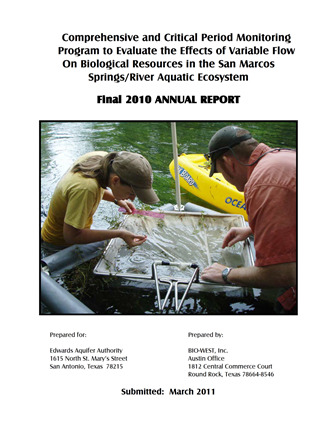Comprehensive and Critical Period Monitoring Program to Evaluate the Effects of Variable Flow on Biological Resources in the San Marcos Springs/River Aquatic Ecosystem Final 2010 Annual Report

| Summary |
|
The purpose of this report is to document the results of all aquatic ecosystem monitoring conducted in 2010 at San Marcos Springs located in San Marcos, Texas. The monitoring and report preparation was performed by BIO-WEST, Inc. Pflugerville, Texas. [Excerpted from Executive Summary] Coverage of Texas wild-rice (Zizania texana) increased from fall 2009 to summer 2010 with an increase of nearly 500 meters squared (m2) in the uppermost section of the San Marcos River…. Flow conditions and recreational pressure in 2009 led to drastic changes in aquatic vegetation resulting in the lowest fountain darter (Etheostoma fonticola) population estimate (normalized estimate calculated based on average fountain darter density per vegetation type over the study period multiplied by aquatic vegetation coverage) of the study in fall 2009. A return to above average flow conditions provided a great opportunity to evaluate how the fountain darter population would recover from the extended lowflow period witnessed in 2009. As summarized above, the aquatic vegetation made a strong recovery which translated into a positive recovery for the fountain darter population as well. In fact, using the same methodology for calculating normalized population estimates, the 2010 fountain darter population estimate was the highest since the study’s inception…. Overall, there is little variation in the average density of fountain darters found among vegetation types in the San Marcos River. As a result, shifts in aquatic vegetation don’t result in dramatic changes in fountain darter densities…. Size class distributions indicate that reproduction occurs year-round (most pronounced in Spring Lake), with reproductive peaks in the spring. San Marcos Salamander (Eurycea nana) densities increased at each site from fall 2009 to spring 2010 as flow increased above the historical average. Fall densities decreased at all sites with the largest drop at the site in the eastern arm of the San Marcos River immediately downstream of Spring Lake. The recent drought in central Texas provided a unique opportunity to observe the biota and associated habitat in the San Marcos River over an extended period of lower than average flows. Above average flows in 2010 yielded a chance to observe how the biota and associated habitat recovered in areas that had experienced impacts during the drought. Continued monitoring of this system will provide knowledge on the organisms’ interactions with variable flows, and also temporal responses that can only be detected over an extended period of time…. |
Search for Documents
Advance Search
Explore EAA's Scientific Reports
- All Reports
- Geomorphology and Caves
- Weather Modification
- Geology
- Water Use and Conservation
- Geochemistry
- Water Resources Planning and Management
- Floods and Drought
- Water Quality
- Climatology
- Surface Water / Groundwater Relationship
- Biology
- Springs, Groundwater Discharge
- Archaeology
- RZ Protection
- Aquifer Levels
- Remote Sensing
- Precipitation
- Overview Studies
- Modeling
- Hydrology and Hydrogeology
- History
- Groundwater Recharge, Recharge Zone
- Groundwater Movement
